Robert Quinn, the Raised Fist and the Man Behind It

The first time Robert Quinn raised his fist during the national anthem, on Sept. 12, 2016, the Rams and the 49ers were moments away from kicking off their season opener. One hundred-thirty days remained in Barack Obama’s presidency. Alton Sterling and Philando Castile had just been buried in Baton Rouge and St. Louis, respectively. Stephon Clark of Sacramento had a year and a half to live; Terence Crutcher of Tulsa had four days. The police officers who killed those four black men would eventually all be acquitted at trial, or not prosecuted at all.
Receiver Kenny Britt stood with Quinn on the Rams’ sideline that night, each player raising a balled right hand toward the Santa Clara sky, just 10 miles from a statue on the San Jose State campus depicting Olympians John Carlos and Tommie Smith doing the same thing 48 years earlier, and for largely the same reasons. On the opposite side of the field, the 49ers’ Eli Harold and Antoine Bethea also each raised a fist. Eric Reid and Colin Kaepernick knelt—this was two weeks after Kaepernick had first been noticed kneeling in a preseason game—as pop violinist Lindsey Stirling played an uncharacteristically mournful rendition of “The Star-Spangled Banner.”
Historians will say little about the Niners winning that game 28-0, or about Kaepernick contributing just three handoffs in mop-up duty. They will recall more readily the events of the two years after those first protests. For starters: Eight weeks later America elected as its president a man who would call these protesting players sons of bitches and rant that they should be fired. Police-involved killings, according to The Washington Post, rose from 963 in 2016 to 987 in ’17 and are on pace to exceed 1,000 in ’18. And, as Football Outsiders writer Scott Kacsmar points out, Kaepernick became the first quarterback in NFL history to throw 200 passes as a 29-year-old (in 2016) and then not appear on an NFL roster at 30.
The former Niners QB remains the face of this movement, but its steadiest presence is a man, born and raised in what was once the epicenter of the American slave trade, who expresses his dissent while standing. Since that first moment in 2016, Quinn has raised his fist during the anthem before every game his team has played, including the eight he missed due to injury, which makes him one of the few constants in this turbulent stretch of player protests.
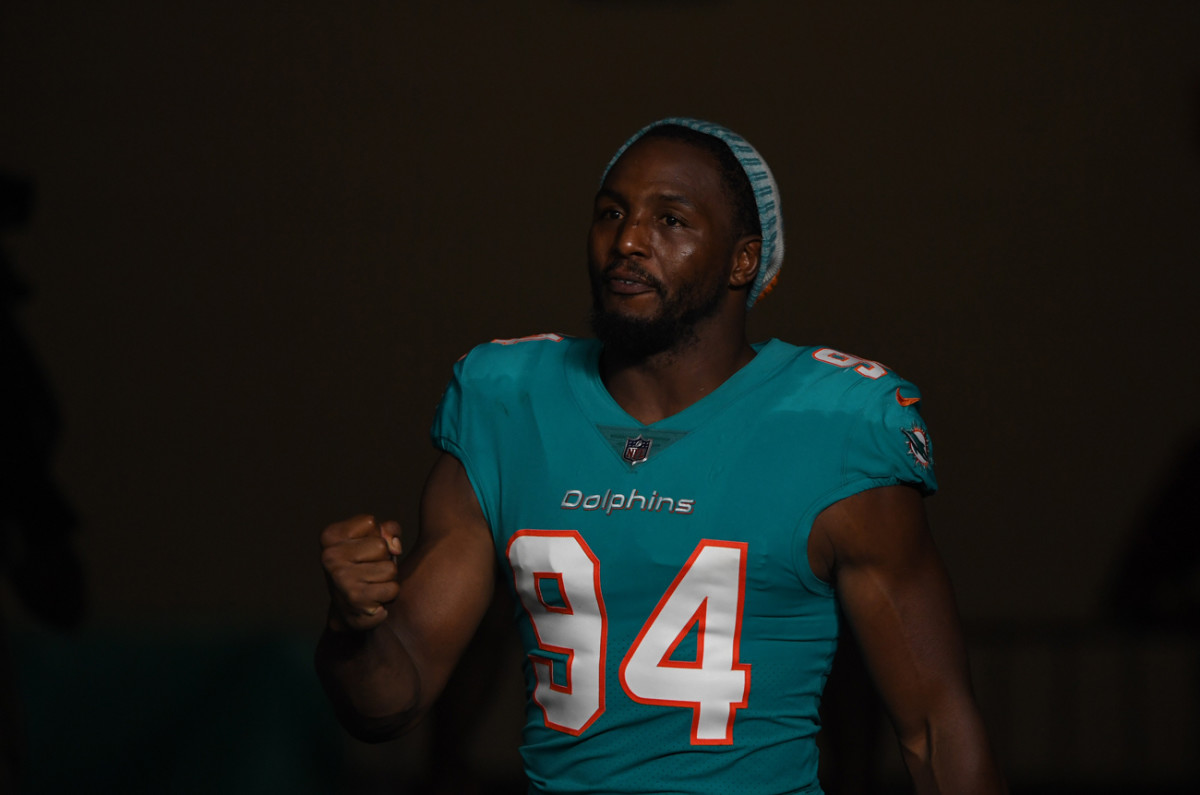
In March, Quinn was traded to the Dolphins, who, it was revealed in an internal document leaked last month, considered fining or suspending any player who protests this season. On Thursday night in Miami, Quinn raised his fist before the Dolphins’ first preseason game against the Buccaneers, and he promises to continue raising his fist. “I won’t stop until they get rid of me,” he says. “That’s going to be the only way to silence me.”
None of it, of course, matters if his message doesn’t come across. Sitting at a picnic table outside the Rams’ practice facility last December, dressed in sweats and a beanie, Quinn lamented “I don’t know if people really know why I’m protesting.” He stopped and reset himself. “Its meaning starts with—I’m gonna be honest—black power. Let’s protect our own. But at the same time I want to unite America. I would like for everyone to quit finger-pointing about who’s this and who’s that. Let’s all be one people.”
Other than raising his fist, Quinn, whose 57.5 sacks since 2012 are eighth-most in the NFL over that period, is not a confident expresser of himself, which he conceded during that and subsequent interviews, with lengthy pauses and comments such as, “Let me think about how to put this.” And, “Sometimes when I speak it comes off wrong.” And, “Does that make sense?”
“This is important to me,” he said, looking down shyly at his scarred fingers, each the size of a premature baby’s arm. “I want people to understand.
“People still think I’m disrespecting the flag. Not just me—everyone who protests. If you’re not African-American, I don’t expect you to relate to it. My ancestors were brought here [on slave] ships, treated like a fraction of a human, under a flag that was created out of wiping out Native Americans. Today that flag tells Muslims and Mexicans, We don’t want you here. We’re supposed to be America—equal opportunity, equal people—but you look around and it’s not like that.”
So he raises his fist during the anthem. It’s his way of saying that the red-white-and-blue spectacle preceding every NFL game hides an important lie he is not willing to tolerate, not even for two minutes. A raised fist, Quinn explains, is his answer to the question Francis Scott Key (a slave owner who once called blacks an “inferior race of people”) posed at the end of the first verse of his song about the Battle of Baltimore, in 1814: O say does that star-spangled banner yet wave / O’er the land of the free, and the home of the brave?
“No,” Quinn says. “Not every American is free. Let’s start back in the day. One of the first names that pops into my head is Emmett Till,” who was 14 when he was lynched in Mississippi, in 1955. “More recently, Trayvon Martin,” who was 17 when he was gunned down by a Florida neighborhood watch coordinator, in 2012. “Is there any real difference between the two? Were they free?”
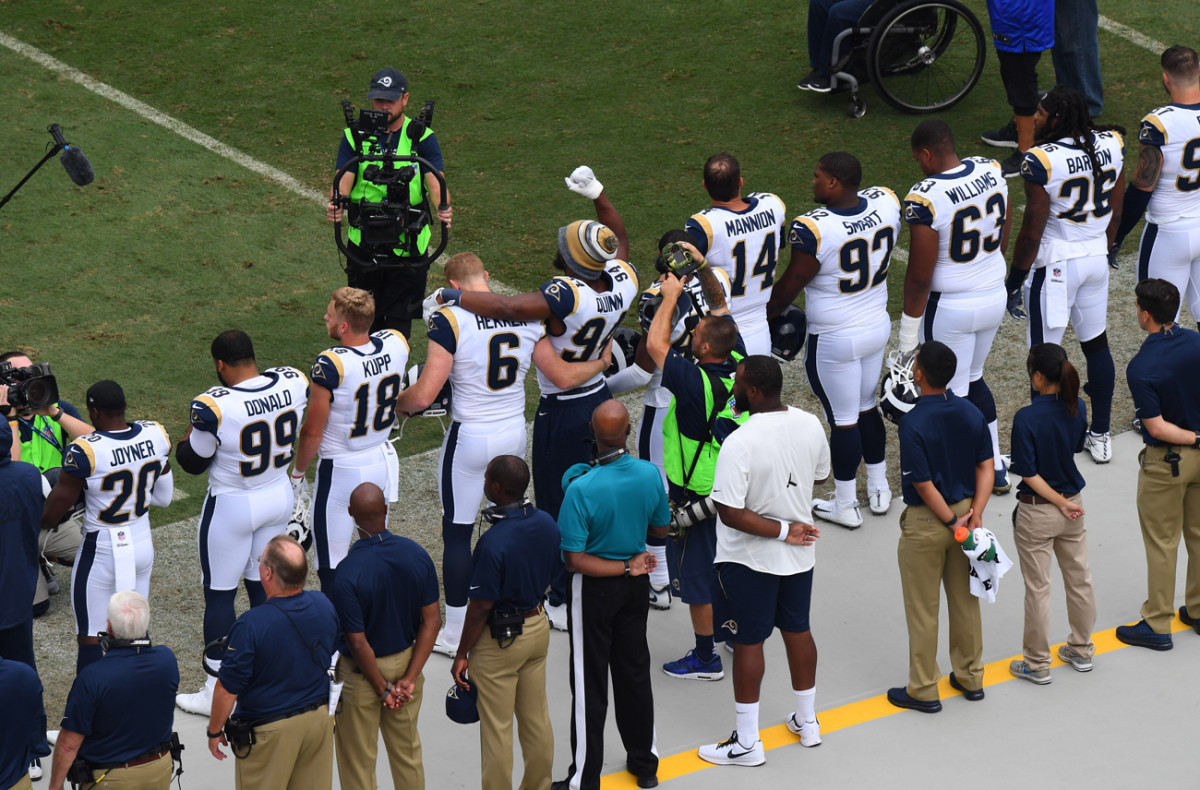
Seventeen months before Quinn first raised his right fist, a 50-year-old black man named Walter Scott was pulled over for a busted tail light near Quinn’s hometown of Ladson, S.C. Unarmed, Scott fled on foot. A white policeman named Michael Slager fired eight shots at Scott’s back, including one that tore through his heart and lungs, killing him. (Slager was later sentenced to 20 years in prison for second-degree murder.)
Ladson, a town of 14,000, lies 19 miles from the Charleston harbor where an estimated 40% of enslaved Africans first set foot in North America. Two hundred years ago the main cash crop here was rice, a stubborn, thirsty product that required several times the manpower of cotton—which is why, at the time of the Civil War, 14 men in South Carolina owned at least 500 slaves apiece. Most of them lived in the Lowcountry, where 130 years later the first dots took shape on a time line that would inform and encourage the protests Robert Quinn engages in today.
“I was walking with two of my cousins—we must have been 12, 13—near my grandma’s house in Monck’s Corner [named for Charles Monck, a local slave owner who branded his human property],” says Quinn. “It was a long, empty dirt road, and a cop just randomly pulls over and says, ‘You look like suspects.’ The first time I was profiled by police, I wasn’t even old enough to drive.”
Steve LaPrad, who coached Quinn for four years at Fort Dorchester High, had never heard that story before. LaPrad, whose program is a perennial supplier of FBS talent, says that when he first saw Quinn raise his fist he felt “surprise.” “Not that it was right or wrong—just surprise. He’d never done anything like that.” LaPrad, who is white, repeats what several locals, including Quinn’s own parents, remember: He never knew racism “was a big deal for Robert at school.”
‘To Change Anything You Have to be Uncomfortable’
Tammy Cobbs raised her kids just down the road from the Quinns. With a laugh, she describes her family as “white, Christian, conservative, home-schooled. We’re probably what people would consider the opposite end—the people Robert’s protesting against.” And yet: Her sons Brandon and Devin used to play with the Quinn kids “from sunup till sundown. My boys always knew that if they wanted an overnighter [with the Quinns] it was a yes. We couldn’t have asked for better childhood friends for our sons.”
Regarding Quinn’s protests, Cobbs says, “I guess I was a little surprised.” She never realized that racism had affected him so personally, she adds. “But that doesn’t mean you can’t have compassion or empathy for somebody else.”
Says Coach LaPrad, “I’m sure me and him don’t see things exactly the same right now, but that guy—the world would be a better place if there were more Robert Quinns in it. I don’t think he has an enemy in this whole Charleston area. So however you feel about what he does [during the anthem], if you know Robert Quinn you just say, ‘It’s Robert, so he’s got a good reason.’ ”
In San Juan, Puerto Rico, 49 years before Robert Quinn first raised his right fist, a janitor-musician named Mariano Camacho Sr. messed around on his wife and got another woman pregnant. Mercedes Camacho was washing dishes when her husband came home and informed her that he’d fathered an illegitimate daughter. “It drove a stake in my mom’s heart,” recalls their now-63-year-old son, Mariano Jr., who was 12 at the time.
Mariano Sr. didn’t want the baby. Nor did the child’s birth mother. So he put the girl in foster care in Puerto Rico and moved with his wounded wife and two sons to New Jersey. When that girl, Maria, turned nine, Mariano Sr. begrudgingly brought her to the U.S., where Mercedes, still hurting, “raised Maria like one of her own,” says Mariano Jr., who gets choked up at this part.
Maria Camacho would go on to earn a track scholarship to Baptist College in Charleston, where she met a hurdler named James Quinn. They married young and in the early 1990s bought a three-bedroom house in Ladson for $64,000. James worked for UPS; Maria worked at Burger King. Robert, the second-oldest of their four children, began working the drive-thru alongside Mom as soon as the law allowed.
The Quinns weren’t poor, but with four growing athletes under their roof they were no strangers to eating Burger King for dinner, either. “Paintballs were expensive,” says Brandon Cobbs, “so Robert and I would go in the woods and shoot each other with BB guns to save money.”
Quinn’s girlfriend throughout high school, Damara Miller, recalls that Robert “didn’t talk much. He never used foul language, except maybe on the field. And I didn’t have to worry about other girls. He was a gentleman.”
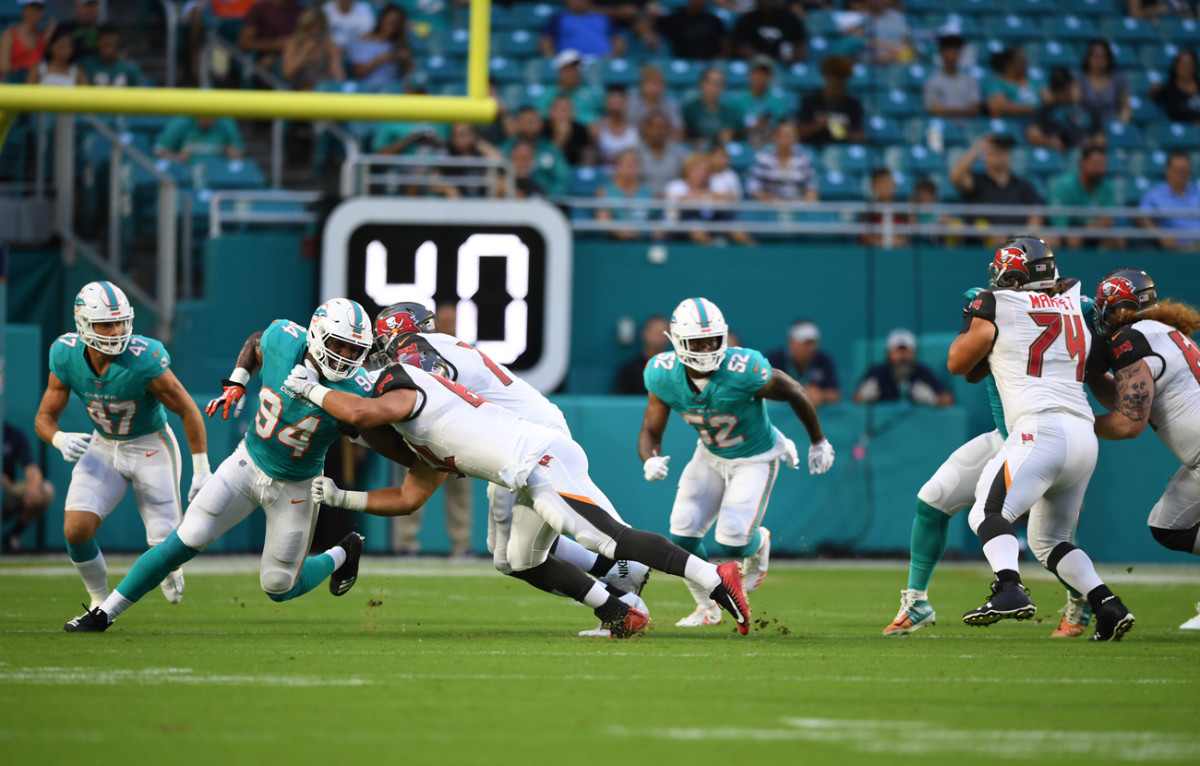
No one cared that Damara was white and Robert was black, says Miller. “He wanted to be a professional skateboarder,” she says. “He listened to [white Nashville rock band] Evanescence. You couldn’t stereotype Robert. He hung out with everybody.
“Personally, I would not [protest during the anthem],” she adds, “but if he chooses to, I support it 100%. Everyone around here knows his heart.”
Maria Quinn—Puerto Rican orphan turned American success story—was as surprised by her son’s pregame gesture as anyone. “At first I was like, ‘What the heck is he doing?’ ” she says. “I asked, ‘Rob, why are you doing this?’ He said, ‘Mom, it’s my beliefs. It’s what I want to do.’ He did say that he wouldn’t kneel, though.”
Quinn’s uncle Mariano Jr. believes that delineation has to do with the 20-year Army career he himself embarked on after his own father moved the Camachos to the U.S. in the late 1960s. Before NFL games Quinn stands against, among other things, the current administration’s immigration policies—which Mariano happens to support. “What Robert does, that’s up to him,” Camacho says. “He’s a grown man. If that’s what he believes in, then I respect what he believes in. But not all of our beliefs are the same.”
His feelings on immigration aside, Uncle Mariano says he is fully on board with the mantra his little sister taught Robert and his siblings when they were toddlers: “Help people when you can.”
Twelve years before Quinn first raised his right fist, back when he was a Fort Dorchester freshman, a close friend of his mother’s needed help. Tammy Gordon had a son, D.J., who suffered from sickle cell anemia. The child’s medications affected his weight, and at age six D.J. was already 100 pounds. “Teenagers really don’t wanna deal with little kids, especially if they look a little different,” says Tori Swain, who managed the Burger King where Maria and Robert worked, and who became one of the Quinns’ closest friends. “But Robert was glad to hold D.J.’s hand and be out in public with him.”
The young boy later tagged along with Robert and Damara to prom; they mingled as a trio and had their formal photo taken together. “D.J. became that little guy everybody saw walking behind Robert,” says Gordon.
Ten years later, D.J. is in high school. “They still talk on the phone all the time,” says Gordon, “texting back and forth, about homework, football, everything.”
Shortly after that friendship began, Robert faced a medical challenge of his own. In the fall of 2007, in training camp before Quinn’s senior season at Fort Dorchester, LaPrad and his staff noticed their star defensive end was playing less aggressively than normal. The coach chalked it up to an improved O-line, but a couple weeks into the season he knew something was wrong. Why was a prospect who’d just been visited by Alabama coach Nick Saban suddenly letting running backs run right by him?
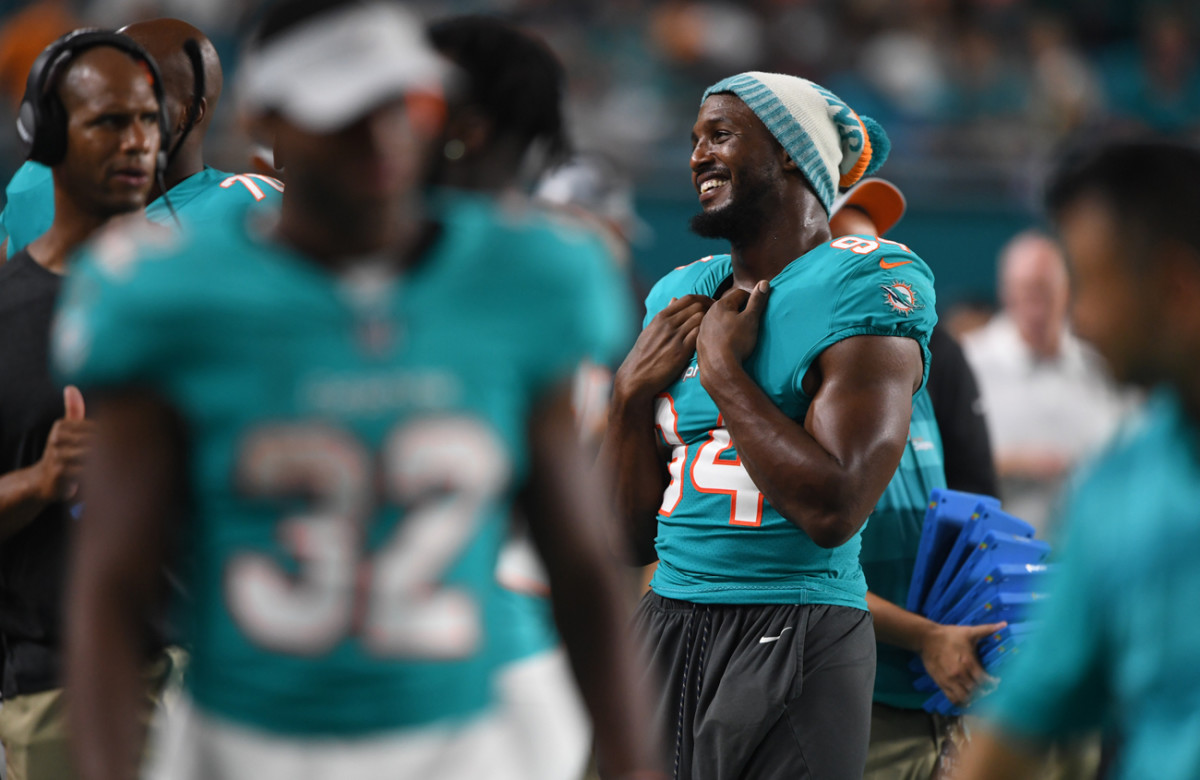
The only person Quinn had told about his headaches was his mom, who had already noticed that his eyes were taking on a yellow cast and that he was struggling to remember things. The day after Fort Dorchester lost to their archrivals, Summerville High, in 2007, he was scheduled for the morning shift at Burger King. Before dawn, his parents heard a Thump! from upstairs. Then another. Robert had passed out, risen, and passed out again. His parents found him unconscious in the bathroom.
Quinn was rushed to University of South Carolina Children’s Hospital, where doctors cut open the back of his skull and discovered a dime-sized tumor on his brain. They took a biopsy and inserted a tube to relieve the pressure.
Suzette Shaw, Quinn’s economics teacher back then, arrived at his recovery room expecting the worst. Instead, she found herself laughing. “It was a children’s hospital, so his bed was half the size he was, and there were cartoon characters all over the walls.” Then she noticed all the tubes and monitors. “He kept telling me, ‘It’s O.K., Miss Shaw,’ ” she recalls, moved to tears by the memory of this frightened manchild willing himself to smile. “ ‘It’s gonna be fine, Ms. Shaw. Don’t cry.’ ”
Quinn’s biopsy eventually came back negative for cancer, but doctors told him he was done with contact sports. The people of Ladson reacted as if he’d died. On senior night, teammates wore a decals on their helmets bearing his initials. The 35-yard line was painted red, honoring his jersey number. “That was a really hard time,” says Miller, tears returning 10 years later. “I just remember his mom looking him in the eye and saying, ‘The devil is a liar.’ That was all he needed.”
Two months after having his brain tumor scraped, Quinn drove the family’s dented Explorer to the state wrestling tournament, where he defeated the defending private-school champion to win his third straight state heavyweight title.
NFL's National Anthem Policy Ignores the Original Reason for Protests: Social Justice
“[The brain tumor] really made me realize that tomorrow is not promised,” says Quinn. “Every day, I’m just happy to wake up with a smile. It humbled me, but it also made me want to do more for others, because my life was almost taken from me. Does that make sense?”
Seven years before Robert Quinn ever raised his right fist, a high school running back named Lavelle Sloan was pulled off the field in Fayetteville, N.C., and into a cancer ward because doctors had found a tumor on his brain, too. Sloan was watching college football from his bed at Duke Hospital later that fall when he heard about a North Carolina defensive end who’d returned to the game following his own brain tumor. A social worker contacted Andre Williams, an assistant at UNC; Williams approached Quinn, a 19-year-old sophomore at the time; and “Robert immediately understood,” says Williams. “You could tell it was very important to Robert to offer any help he could.”
The Tar Heels hosted Sloan at a game, and Quinn met with the boy on the field before kickoff. Later he paid Sloan a surprise visit in his hospital room, where they were left alone to talk while relatives wept tears of gratitude in the hall. Everyone knew the boy’s prognosis was bleak. “We talked football; we talked about life,” Quinn told the St. Louis Post-Dispatch the following spring, slightly miffed that the paper in his new NFL city had found out about the budding friendship. “My doctor told me I was supposed to be brain dead, so I’m living testimony that [a recovery] can happen. . . . I wanted to give him hope. . . . That’s all you have to cling to.” Sloan fought for four more months, then passed away on April 14, 2010. But among the memories left behind is a framed photo that still hangs on Marilyn Sloan’s living room wall, of Robert Quinn and her son.
Charlottesville a Year Later: A Football Team Remembers
That relationship unfurled behind the scenes, the setting Quinn prefers for such outreach. When he began taking a public stance on NFL sidelines two years ago, “in a way that other people would notice,” says Swain, “that’s when I knew it was a big deal for him. He has never been one to call attention to himself, and he has always done the right thing by other people.”
She pauses. But “he hasn’t always made the best decisions for himself.”
Following UNC’s spring game in 2010, Quinn accepted an agent’s gift of an all-expenses-paid trip to Miami, where a jeweler gave him two black diamond watches and a pair of matching earrings. The trip and the jewelry totaled $5,642 in improper benefits, and when the NCAA found out, Quinn and two other players were declared ineligible for the season.
Quinn issued a statement in which he apologized to his teammates and coaches “for bringing this burden upon them,” but he also lied to NCAA investigators during his initial interviews. He was booted from the team and three years later, during his third season in the NFL, received a letter of “permanent disassociation” that prohibited him from contacting UNC student-athletes, from entering the Kenan Football Center and from “further embarrassing” UNC and “jeopardizing [its] commitment to full NCAA rules compliance.” Carolina’s “integrity . . . has been damaged through your actions,” the letter continued.
But if you pick up the Tar Heels’ most recent media guide, which is equal parts recruiting pitch and PR instrument, you’ll still see Quinn listed as the recipient of the ’08 Brian Piccolo Award, given to the ACC’s “most courageous” player; as a member of UNC’s ’11 NFL draft class; and as one of the program’s 24 all-time first-round picks.
The disassociation knife only cuts one way, apparently. “I just find these things interesting,” says Quinn, who enjoys talking about the Carolina controversy as much as he likes discussing his impact on the lives of D.J. Gordon and Lavelle Sloan. Which is to say: not at all. But he cannot stop the stories that flow forth from the people he has touched, George Bailey-like, over his 28 years.
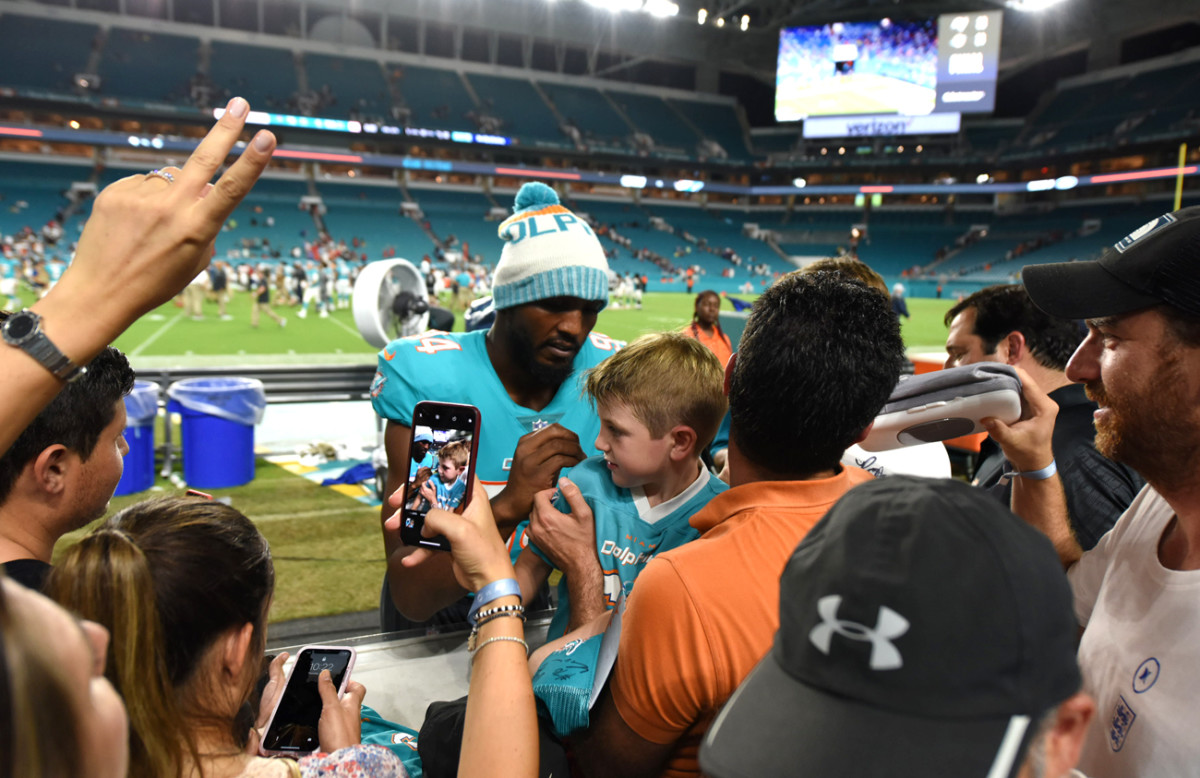
“He was injured when we won the state championship two years ago,” says LaPrad, Quinn’s coach at Fort Dorchester. “He and [his wife] Christina flew in for the game, and afterward he handed me a $50,000 check to buy the kids rings. I didn’t ask him for that.” The rings ended up costing quite a bit less than 50 grand, LaPrad adds, and “we’ve done a lot of good at the school with that money.”
A few weeks later, around Christmas, Rebecca Carter, a single mother in L.A., was preparing to move into a government-subsidized apartment with her six kids—a refuge, finally, after years of homelessness and domestic abuse. She expected the unit to be empty. Instead she found it fully furnished, filled with school supplies and groceries, with a Christmas tree and presents, all courtesy of Quinn and a teammate, Tavon Austin. Those two extended the same kindness last December to a mother of six, Shwonna Cox, who’d been displaced from two apartments in two weeks by wildfires that affected L.A.
There are myriad examples of Quinn’s preference for discreet, direct impact over the broader political reforms sought by players like Chris Long, Quinn’s friend and former Rams teammate. To that point, Tammy Gordon shares a story from the 2017 offseason. Robert had returned to Ladson for a free youth camp that he and Fort Dorchester teammate Carlos Dunlap (now with the Bengals) host every summer. That Sunday in church, she says, “D.J. came running up to me, saying, ‘Mama! Robert just texted and he said if we pack a bag right now, I can come to California with him!’ ” By the time they got home and put a bag together, Quinn was at their door, boarding passes in hand, and D.J. stayed in L.A. with the Quinns for six weeks.
D.J. wants to play football, but his medical condition has made that dream impossible. “Robert always tells him there’s more to life than football,” says Gordon. “And D.J. wants to be a chef. He likes to cook.” So last summer, in California, Quinn invited a culinary instructor to his home to show D.J. a few things in the kitchen.
“I don’t want to get political,” says Gordon. But she does want to make it clear that Quinn isn’t protesting “because he hates America. He’s doing it because he has a big heart.”
Eric Reid said earlier this year that he’d stop kneeling if he regains an NFL roster spot. Another contingent of players, led by the Eagles’ Malcolm Jenkins, decided to stop protesting last November after the league pledged $89 million to various social justice platforms (although Jenkins raised his fist before Thursday’s preseason game against the Steelers). Quinn has never discussed the protests with these men, but he says he hopes other players aren’t “afraid of making their stance because they don’t want to stop making a dollar and survive.”
He can already hear the response from fans—Easy for you to say, millionaire—and this is where the guy who played paintball with BB guns and rode his bike to work at Burger King digs in. “Let’s erase money,” he says. “How would we function? You’re growing apples, I’m growing oranges, that person over there is growing lettuce. Now we have to take care of each other. Versus: I’m your boss. Listen to me. I pay you two bucks and you make me 50.’ ”
It’s a radical vision, but it’s consistent with Quinn’s belief that some of America’s dearest institutions need overhauling. Racism and the quest for personal gain, he says, have become too entwined in this country’s roots. And in the NFL’s, too—from the league’s spotty history regarding player safety to its clumsy responses to player protests to its lopsided hiring practices. In April, Quinn fired off a text message that cuts to the heart of that last issue, evoking the days of Thomas Monck:
No black owners.
Barely any black coaches.
Players, 77% black.
For years, Quinn has heard the establishment tell minorities, We know, just hang in there. But for how much longer? his raised fist asks. How long can we ignore that the American experiment—freedom for all—is either a hoax or it requires far more effort than is currently being expended?
This is why Quinn prefers grassroots work. This is why he and Rams tackle Andrew Whitworth quietly donated dozens of tickets to kids in a Pop Warner program in Watts last year. It’s why he said yes when Rams punter Johnny Hekker asked if he could stand next to Quinn during all those anthems, with his pale hand on Quinn’s shoulder, “to let white people out there know that it’s O.K. to speak up,” Hekker explains.
Quinn’s in Miami now. But his fist will stay up, as surely as he will continue getting biannual checkups on the brain tumor still inside his head. As surely as he keeps listening to “Blessings,” by LeCrae and Ty Dolla $ign every morning. If I ever took a loss I learned a lesson / I won’t ever think I’m better than the next man / If you woke up this morning it’s a blessing.
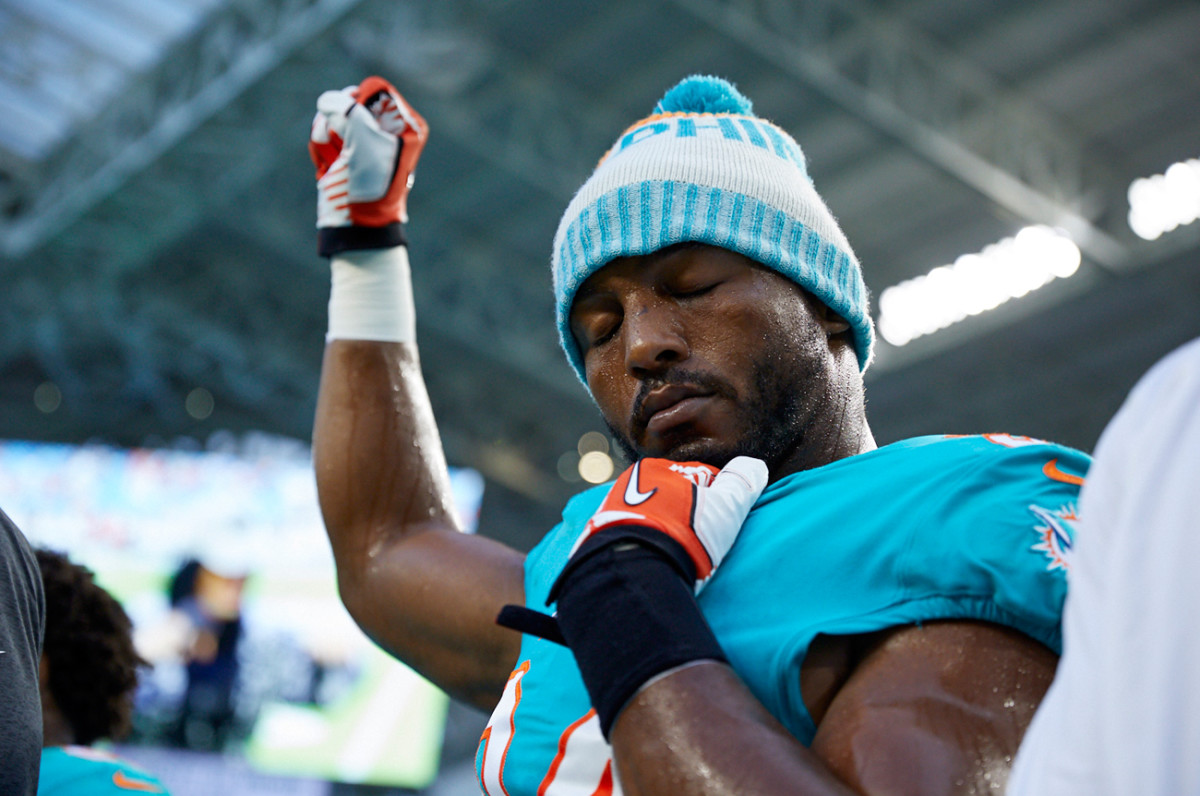
“There are disadvantages that come with having brown skin in this country,” says Hekker. “Being a white man, it can be difficult to see these things, but they’re undeniable. The people who are affected—Rob just wants to lift those people up.”
That’s the detail Maria Camacho Quinn says most people misunderstand about her son’s pregame pose: “It’s not about Robert Quinn at all.” It’s about the people he’s lifting, sometimes by the scruff of the neck, saving them, if only temporarily, from their oppressive day-to-day—an image that looks for all the world like a man raising his fist.
Question or comment? Email us at talkback@themmqb.com.
